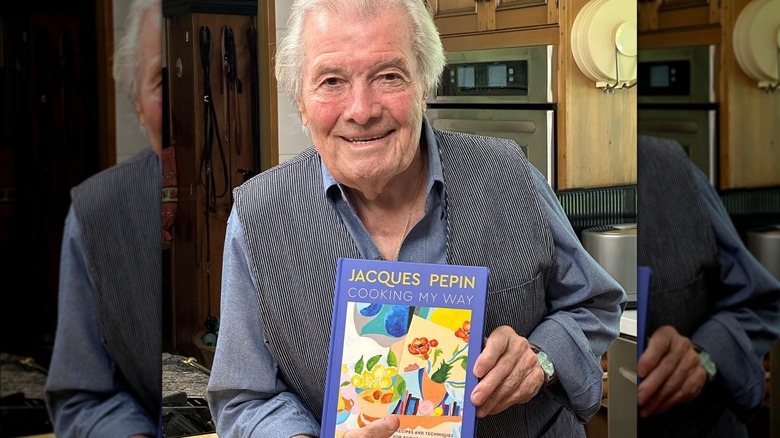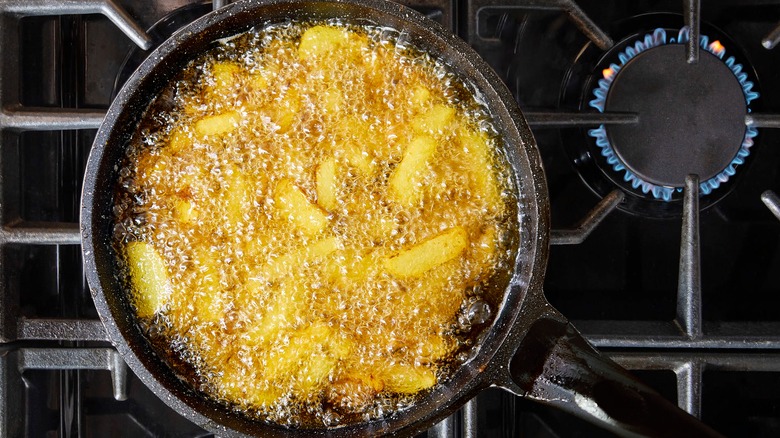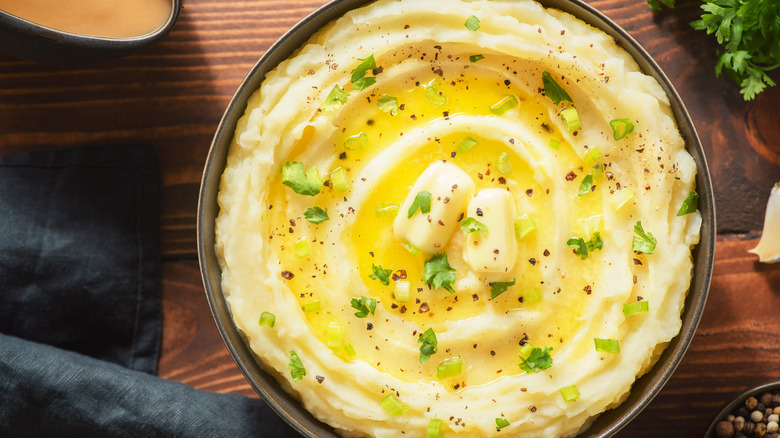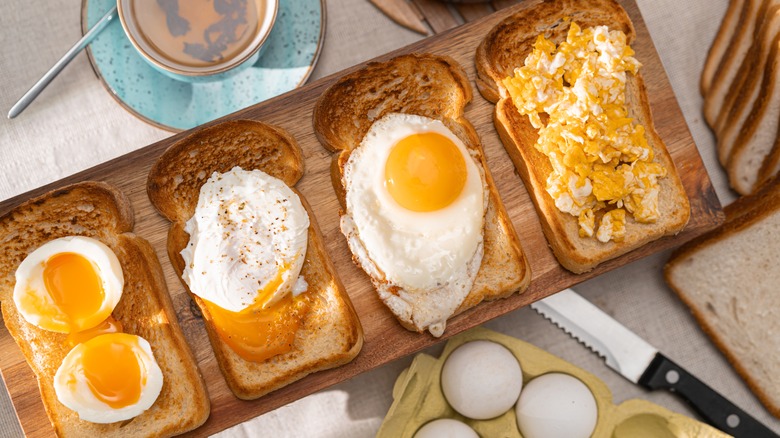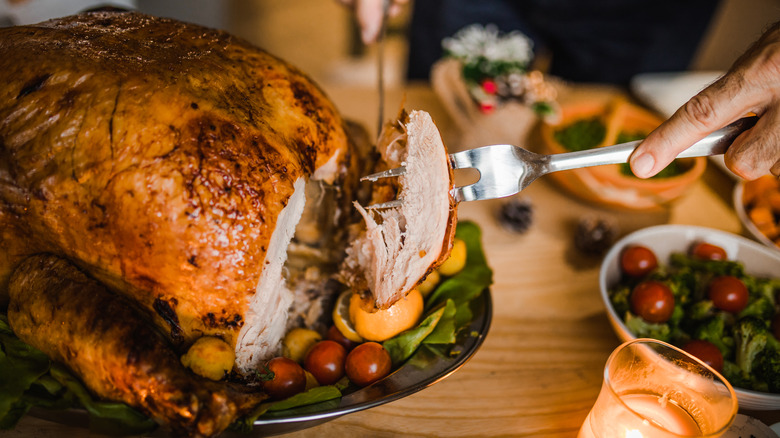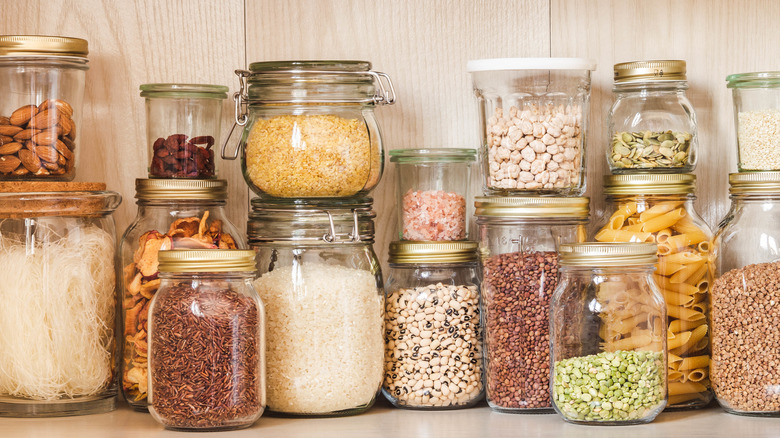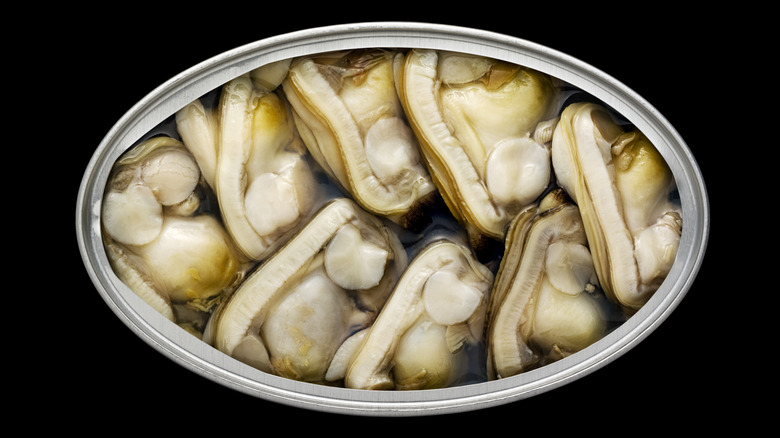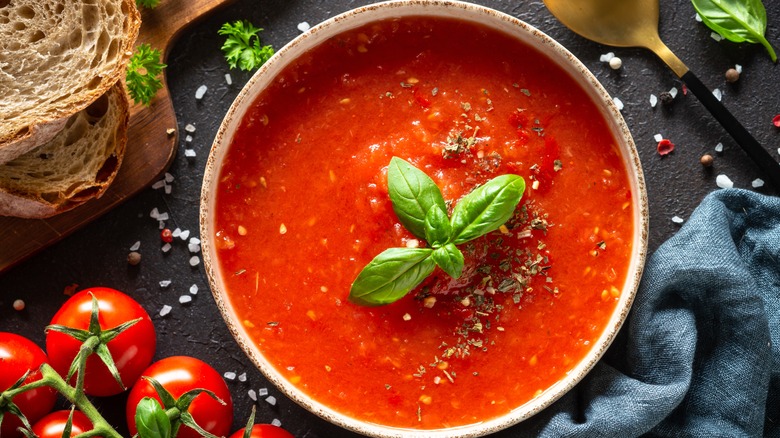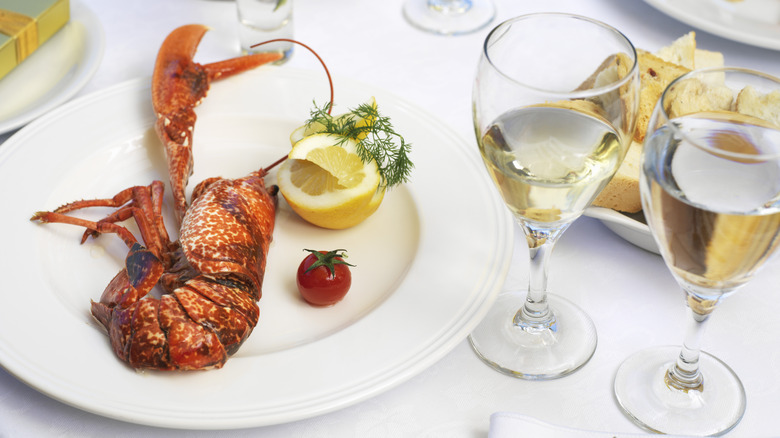Jacques Pépin Wants You To Cook With The Season - Exclusive Interview
Jacques Pépin has been a force in the culinary world for decades. Born to a family of culinary masters in 1935 in Bourg-en-Bresse, France, Pépin began his career in esteemed restaurants in Paris and later served as a personal chef for several French heads of state. In 1959, Pépin moved to the United States and brought his expertise in French cooking to an American audience through his position as Director of Research and Development for Howard Johnson and his numerous acclaimed cookbooks and television programs.
While Pépin is perhaps best known for his mastery of French delicacies, he shines as a culinary educator, making his cookbooks accessible and vital texts for any home cook looking to expand their repertoire and learn how to approach cooking through the lens of experimentation, flexibility, and resourcefulness. We recently connected with him in celebration of his latest cookbook, "Cooking My Way," to talk about economical and mindful strategies for making the most of the food already in your refrigerator and pantry. Speaking exclusively with Tasting Table, Pépin shared his connection to food as an extension of memory, his favorite ingredient to use in the kitchen, and several tips for preparing humble but delicious meals at home.
The economy of time in the kitchen
Throughout your legendary career, you've made immense contributions to the culinary world. What do you hope home cooks will glean from your newest cookbook, "Cooking My Way"?
Well, this is a new book, but I've already cooked this way. I did over 30 books — I did 13 television series. Each time, there was a special theme and we did a book [to go with it]. I also did a book for the Cleveland Clinic for cardiac patients. Each time, you put your mind or your knowledge of cooking to a very specific area of food. In the '80s, I had a column in the New York Times called "The Purposeful Cook," which was to cook for a family of six people for the least amount of money. That was where the idea [for "Cooking My Way"] came from ... I'm very happy with it. They did a beautiful design and it looks good.
In thinking about cooking purposefully, what are some of your favorite tips for sourcing food economically?
To start with, I tell people to cook with the season — without any question. I have a lot of tomatoes in my garden now, but even if I go to the farm next door, the tomatoes are cheap now because it's the full season. Not only are they cheap, but that's basically when they taste the best — that's when they really taste good. In addition to that, that's when [tomatoes] are nutritionally good for you and cheap.
You can look at all of those [regions], from Sicily to Sardinia, where the people live [until they're] very old. They usually follow the season — eat simply, and so forth. To a certain extent, that's the first thing that I would tell people to save money.
Secondly, I never [waste] leftovers. I always [make] what my wife used to call a "fridge soup." I open the refrigerator and [see that] I have a wilted salad and a piece of carrot and an onion and this and that — I will boil that with some chicken stock or water and finish it with some pasta and all that to make a soup.
There is also the economy of time — the economy that you learn through cooking. For example, when I do a recipe, if I have to use the food processor three times, I start by, let's say, grinding bread in it so I don't have to wash it. The second [time], I may do nuts. For the third [time], if I do fish, then I have to clean it, but I work it out so that I use it two or three times before cleaning it. Likewise, with a skillet, I use the skillet, then I run it briefly underwater so that I can use it again. If you economize time in the kitchen, the economy of motion, that makes a very rewarding type of cooking that people will enjoy.
Delicious food doesn't have to be elaborate
Several recipes in your new book are designed to be used as outlines, allowing home cooks to alter the dishes based on ingredient availability and preference. Specifically, your recipe for rhubarb compote with sour cream encourages readers to use what they already have in their pantry. Can you speak more to that directive?
I usually tell people: When you do a recipe, whoever you take the recipe from, you should do it exactly the way it is [written] without changing it. If it happens to be good, you're likely to do it again. The second time, you may do it again according to the book. By the third or fourth time, you start changing it and massaging it to your own taste and your own sense of aesthetic.
Eventually, a year later, you may have done that recipe 10 times — you don't even remember where it comes from. Now it's your recipe, you did it — you massaged it enough so it's yours. Certainly, [in the rhubarb compote], I use leftover jam and jelly that I have in my refrigerator. The recipe may say that it's apricot jam, but if you don't have apricot jam — you have peach jam or a different one — you use the other one, without any question.
Can you share some guidance for repurposing leftover ingredients and transforming them into a delicious dish?
[If] I have some leftover bread, which often I have ... I cut it into little pieces and soak it with a bit of milk to soften it and add an egg to it and some herb and some onion, maybe garlic. You can do a beautiful pancake with that in a skillet. It's cheap. It's delicious. You can serve that by itself or with a bit of sour cream or whatever. It's important to use leftovers.
"Cooking My Way" features updated versions of some of your favorite childhood meals in post-war France. Can you share some of your favorite meals throughout your life?
Oh boy, that's an impossible question. When I was a kid, I was raised during the war, so there wasn't much to eat. My mother was a great cook, no question about it, but very miserly in the kitchen using everything, as everyone was doing at the time. Also, it's not even [just about] the time; it's a question of the culture. I think women do that better than men most of the time. In my family in France, I count 12 restaurants throughout the years, all of those run by women: my two aunts, my sister-in-law, my niece, my mother, and so forth.
Often, Americans are not aware of that [type of cooking]. They think of French cooking in the context of the Michelin guide — very elegant, very beautiful cooking. That's fine; it's part of it too. There are only, I think, 12 or 13 three-star [Michelin] restaurants in France. There are like 138,000 restaurants in France. The type of cooking that my mother used to do is often what I want to talk about in [my] books — it's usually inexpensive and tasty.
Recipes of childhood
You have a beautiful recipe for garlic mashed potatoes that's inspired by the way your godmother used to prepare it. Can you share what that recipe means to you and how you view the connection between food and memory?
Frankly, the recipes or the dishes that you eat as a child are very powerful — they stay with you, those tastes. Regardless of where you are in the world — whether you come from West Africa, Portugal, or Zambia, it doesn't matter — those dishes of your youth become very powerful. In times of stress, people go back to those recipes because it's more than the physiological function of food. Those recipes mean family, they mean home, they mean love, they mean security, and so forth. We go back to those tastes wherever we are, wherever we come from.
Mashed potatoes ... My mother would get these tiny potatoes out of the garden when we were kids — they were like fingerling potatoes now. She got them just before cooking them. She rubbed the skin and the skin slid off since they'd just come from the ground; then she'd blanche them and sauté them with peanut oil and serve them with a curly endive salad — a lot of garlic dressing in it too. Those were visceral tastes for me that I still remember as I get older.
Eggs are the most important ingredient in the kitchen
There is an entire section of "Cooking My Way" dedicated to eggs. Do you have any special tips you'd like to emphasize for hard-cooking eggs at home?
Eggs are an extraordinary thing — maybe the greatest thing you have in your kitchen. It's a very humble type of thing. Not only can you have hundreds of different dishes on eggs, but you can get thousands of other dishes [by using them], whether it's cake, gratin, [or simply] cooking with eggs in one form or another.
Eggs, for me, have always been very important. I used to have chickens. Now I'm fortunate; I have a lady who lives next to me and she raises chickens and ducks. I go get my eggs [from her]. You can't beat a fresh egg. If the chicken is happy and if he eats well and everything, he will give you a very good egg. I don't think there is any reason not to buy organic eggs. They're still a little more expensive than regular, but still very cheap. If I had to choose one ingredient that I couldn't do without, it probably would be eggs.
That reminds me of a very special egg recipe in the book, your eggs in poblano boats.
My wife loves those. I used to do that for her. She liked the pepper, the poblano. Sometimes you bite into them and whoa, it's like a jalapeno — like a green pepper, so you have to taste it [first]. You can vary the recipe. I put some cheese and some ham underneath. Depending on what you have left over — even a bit of fish or whatever — if you have leftovers from the day before, you can put them in the bottom of the poblano, then put your eggs on top, cook it in the skillet, and have a great lunch or brunch.
What led you to choose the poblano pepper for that dish?
Because it is oval, it's deep enough, it's good. You can absolutely use regular green pepper or red pepper or whatever; that is perfectly fine. [You're] just using [the pepper] as a vessel to be able to cook the food inside.
Using every part of the turkey
"Cooking My Way" features several innovative turkey recipes. A particular standout is your turkey liver toasts. How does using turkey liver instead of chicken liver affect the flavor profile of the dish?
It doesn't, really. I use duck, chicken, or turkey liver, and they all work fine. The turkey liver will be the one to get dry faster. You have to be careful when you sauté that liver with the fat — with chicken fat, or turkey fat, or oil, or butter. You have to be careful to make sure that it's pretty pink inside when you start cooking before you emulsify it; otherwise, it will be dry.
You can buy half a pound of chicken liver or turkey liver and some chicken fat. It's very inexpensive. Sauté that with some onion and garlic and emulsify it in your food processor — it's almost like foie gras, like a rich pâté. You can put it in a bowl or container. It freezes very well. I always do that. I probably have five or six [containers] in the freezer now. When I do it this way, if I have people coming for a drink, I take one of those containers out and we have it with toast. It's a great thing to do — inexpensive and quite delicious.
What attracts you to using turkey meat in your recipes?
I didn't discover turkey in America, but I discovered Thanksgiving — we don't celebrate in France ... You can do scallopini — slice it thin like veal and sauté it with cream sauce. With the skin of the turkey, you can do cracklings, which are as good or better than bacon. You can put that on toast, in a salad, and so forth.
With the dark meat, you can do a beautiful fricassee of turkey ... I use that [recipe] a lot when I have turkey for Thanksgiving, then for two or three days, I have turkey dishes. You can [make] them with rice or with potato or with anything like that; it will come out good.
The book has a wonderful recipe for turkey wings.
I happen to have [turkey wings] at my market, so I buy them because they're about two or three times the size of chicken [wings]. You can do them in the same way [as you would with chicken], on the grill or with hot sauce basting on top, or you can actually cook them with rice like a paella or pilaf. You can do a lot with them. They're usually quite good and meaty.
My market always has them around Thanksgiving time. They will have turkey giblet and turkey neck — turkey neck is great too. You cook that with rice, or you can do a soup. They are very meaty and delicious — very moist meat and very inexpensive too.
Making the most of your pantry
Your recipe for pasta e fagioli utilizes pantry staples like pasta, canned beans, and canned tomatoes. What guidance can you provide for home cooks looking to make use of the ingredients in their pantry?
I use a lot of stuff from my pantry. Pasta is one of them. When people come to eat unexpectedly, I [always] have pasta. With pasta, you can put in all kinds of vegetables that you have around. A soup with canned beans is also very good. If you don't have those, you can do [a soup] with meat, you can do one with fish ... At the time of the year when I have a lot of basil in my garden for free, I will use a lot of basil in the recipe.
You were talking about a specific recipe, the pasta e fagioli. With the beans, usually, I will use unsmoked bacon or pancetta and some onion and garlic. You can use canned tomato, as well as fresh tomato — whatever's in season. The pasta can be spaghetti, cannelloni, bow tie pasta, or whatever [you have].
Then you add a can of beans — cannellini beans or even red beans. Beans always extend the dish a great deal. They make it very nourishing, delicious, and satisfying. That's something we do often. Even if you have leftover pasta, you can reuse it — put a little bit of fresh herbs in it and a can of beans, and you have another dish.
Your recipe for flan of green herbs features all of the herbs in your garden. How do you recommend utilizing multiple herbs within a single dish?
I have a lot of herbs in my garden. Sometimes I have even done a salad of basil, parsley, chive, and tarragon instead of a green salad. You can use herbs in different ways. You can freeze them. Sometimes I blanche them, sometimes I don't; sometimes I put them in the food processor with a little bit of salt and a dash of oil. I make a little package, two tablespoons or so, of chopped herbs like this. Then you can have them during the winter when you need herbs. You grab those [packages] and they are there and flavorful and cheap.
The magic of canned goods
Your recipe for New England clam chowder — inspired by the dish you served at La Potagerie in New York — advises home cooks to use canned clams. What are the benefits of using canned goods?
Canned clams are very good because they are cooked for a long time. They are tender. You can cook clams, you can eat clams raw — which I love; they're very nice and smooth. If you cook them for a minute, maybe a minute and a half, they will still be very tender and good. But if you cook them for five minutes, they turn into pieces of rubber. If you cook them for an hour and a half, then you have clam chowder and it's tender. It's one or the other. It's tough to go in between.
Very often, it's easy to use a can of beans like this because [the beans] are cooked — they're ready for you. You can finish a soup [with canned goods] or do something else with them. That's what I did for the New England clam chowder ... I worked for Howard Johnson for many years as Director of Research and Development, so we used to do a clam chowder. We used to do 3000 gallons of clam chowder at a time. This [recipe] is quite different, but it's still a good thing to sauté [the clams] with a bit of potato and some corn at the end if you want to. It's very New England.
The simple comfort of eating at home
What is your favorite comfort meal to prepare at home?
Probably soup now as I get older and older. This summer, I had an enormous amount of zucchini, so what do I do with it? I put them in a pot and I put an onion with them and see what I have. Then I make a soup and emulsify it — put it into a container, put it in the freezer, and have it. I did the same thing with cucumbers. I had so many cucumbers.
I peel them, take the seeds out of them, cut them into two pieces, then put them in the blender. Usually — like I did last week — I put some spicy V8 in, directly on the cucumber. I had gazpacho in one second. It was very good. I did another one the week before where I did the cucumber the same way with a bit of garlic, and I did yogurt with it and mint in it afterward to do another cold cucumber soup. We use it in one or the other.
Are there any specific dishes you prefer in your home kitchen rather than at a restaurant?
Yes, there are many dishes like that. You do a little stew sometimes at home. You sauté some chicken legs, for example, two or three of them, and you braise them nicely on top of the stove or in the oven. You finish them with tomato, garlic, whatever. You can do a dish sometimes that is difficult to duplicate in restaurants when you do it in larger quantities. It doesn't come out exactly the same. Very often, people realize that in restaurants, you cook things à la carte when people are ordering, so you do one dish at a time. You may do 200 people at night, but you do one or two dishes at a time in small portions.
The pleasures of eating in the world
Are there any dishes that you prefer to eat at a restaurant?
Certainly, a dish made from lobster or different types of fish, which are too much work to do at home. In a restaurant, it's easier to enjoy them — to enjoy certain things like pâte and all that, which takes several days to prepare, certain types of dessert like vol-au-vent. I would enjoy those more in a restaurant than at home.
Do you have a favorite French restaurant in the United States?
Probably [eating] at home. [Restaurants] are so different — between a bistro where you're going to eat very simple food, to something like Per Se or Daniel in New York that may cost a thousand dollars. They're really not comparable. Of course, I'm very lucky because I'm always invited to those restaurants. As I mentioned, Daniel in New York and Per Se are fantastic restaurants. I wish I could cook as good as them.
"Cooking My Way" is now available for purchase here. Keep up with all things Jacques Pépin and the Jacques Pépin Foundation on Instagram.
This interview has been edited for clarity.

